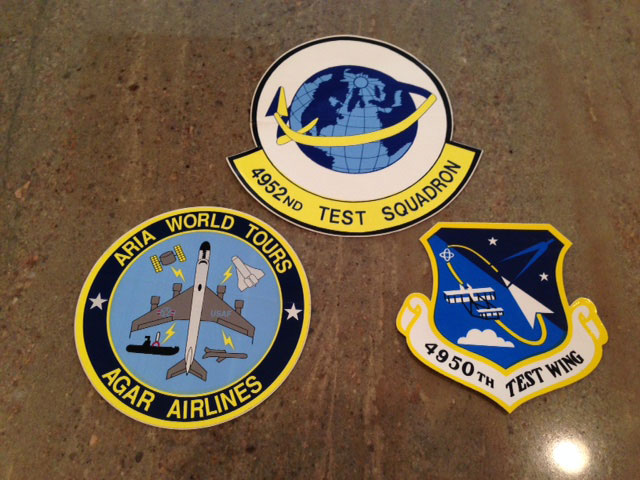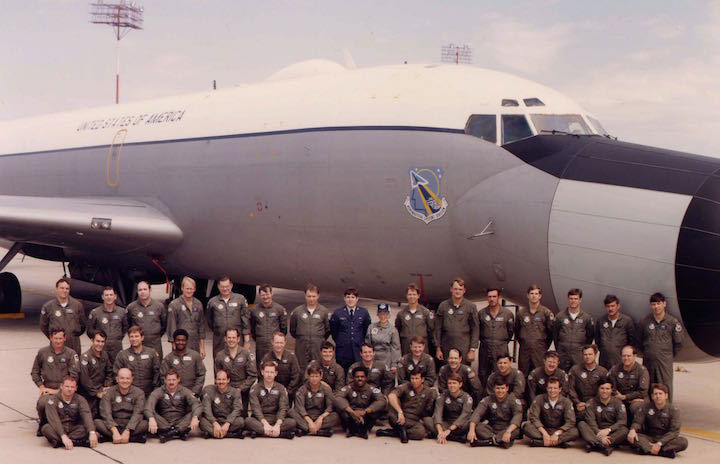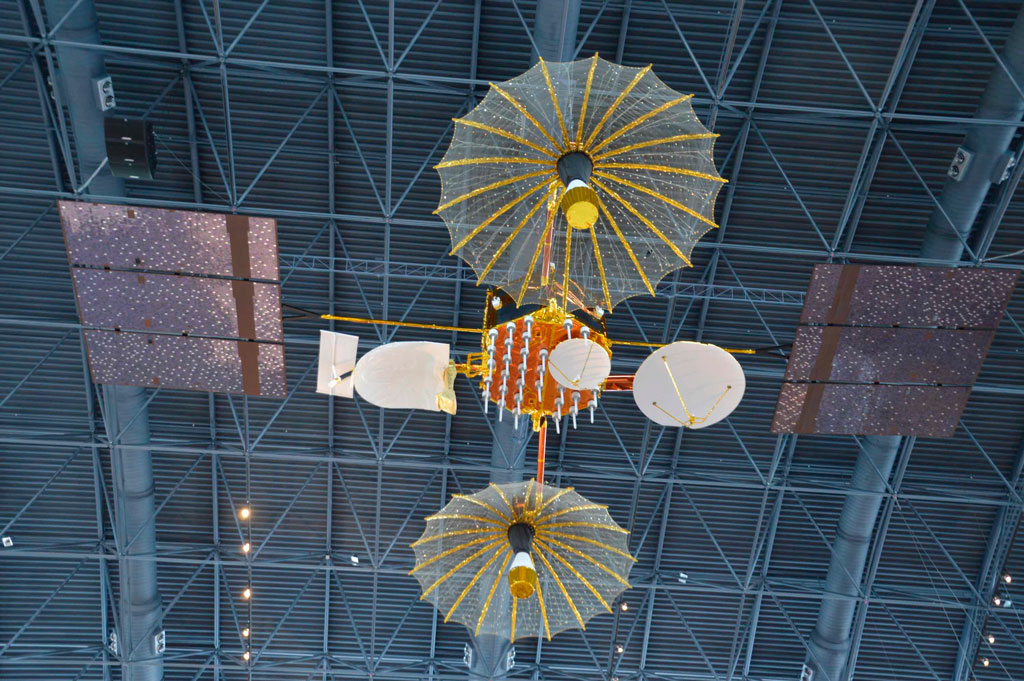In the 1960s, the US launched (pun intended) into a new frontier…space and the race for the moon. The US discovered that in order to achieve this lofty goal, it required a premier agency to oversee the program, thus the National Aeronautics and Space Administration (NASA) was created. NASA quickly noticed a need to acquire launch tracking and telemetry data in hard to reach locations around the world. Thus a military program/aircraft was built called the ARIA.

The nose held a small, steerable satellite dish. This plane is pictured at the National Museum of the US Air Force in Dayton, Ohio.
The ARIA (Apollo/Advanced Range Instrumentation Aircraft) mission collected telemetry data during launches in locations where signals would be lost by lack of ground stations (particularly over the oceans). Why does that matter? Believe it or not, space, even around measly little old Earth, is a big place. When NASA launches into space, it does so along a particular trajectory. If the craft deviates for any reason, then it will enter space on a slightly different path and could easily become “lost in space” (ie. the telemetry tells NASA what orbit the vehicle is in).
Mission requirements caused the deployment of personnel around the world. Sometimes this took the plane to a small island in the middle of an ocean with a less than nominal (read dangerous/difficult/no alternate landing site) runway. Other times, the planes landed in paradise. Below are listed a few of the sites and what led to the design of a fun logo “ARIA World Tours” seen in the photo below.

Deployments (a few from a long list):
- Easter Island
- Thule, Greenland
- Guam
- Tahiti
- Recife, Brazil
- Saipan
- Sidney, Australia
- Singapore
- Capetown, South Africa
- Cold Lake, Canada
- Dakar, Senegal
- Ascension Island
- [David J Dunn, ARIA Mission Coordinator (1967-1972) suggested I add the following:]
- Puerto Rico
- Trinidad
- Surinam
- Liberia
- Johannesberg
- Mauritius
- Cocos (Keeling Island)
- Darwin, AU
- Perth, AU
- Townsville, AU
- Wake Island
- Hawaii
- Bermuda
Also lost over time is the meaning behind “AGAR,” the call sign used for the aircraft. If anyone knows when or how the name AGAR came about (it was used first at Patrick AFB and carried forth), please let me know so I can pass it along.
At a recent union for those involved in the ARIA mission, my husband and I toured the Smithsonian Air and Space Museum. In a corner behind a huge rocket engine nozzle, we found this note about the mission: “A system of 14 ground stations, 5 instrumented ships, and 8 aircraft made up the Manned Spaceflight Network in 1969. The network provided data for tracking and communicating with Apollo 11. Look closely for the plane’s large round nose, which housed tracking instruments.”

The original ARIA aircraft were built on the Boeing C-135A frame and designated EC-135As. Later they were augmented by used Boeing 707 aircraft and were called EC-18s. They flew missions from 1968-2001 from the following locations.
- Patrick Air Force Base, Florida 1968-1975
- Wright Patterson Air Force Base, Ohio 1975-1994
- Edwards Air Force Base, California 1994-2001
People who lived in Melbourne, Florida or Dayton, Ohio or Lancaster, California might remember seeing these odd aircraft.

So why did their mission end after 2001? ARIA’s replacement, a new satellite named TDRS (pronounced TeeDRiS), arrived in space. The Tracking and Data Relay Satellite, was built by TRW corporation and is now in its fourth generation. A first generation satellite example hangs in the Smithsonian’s Steven F. Udvar-Hazy Center near Dulles Airport. I snapped the photo below there last month. It makes me wonder if ARIA covered the launch of its replacement.

For more information about the ARIA, check out the website. Also check out David Dunn’s blog for a great story about ARIA being the first to receive contact from Apollo 13 after it survived re-entry and was the link for their communications between Houston and the spacecraft.
Please be sure to leave comments or share a story or provide further information about the ARIA. Thanks for stopping by.

yes, i was an aria crew member from 1981 to 1984 and i do indeed remember covering tdrs missions.
Saw this today and noted I hadn’t replied. Sorry for the wait! Thanks for stopping by and commenting. I’m assuming you flew out of Wright-Patterson where my husband was stationed for several years. Check out David Dunn’s blog (info at the end of my blog), he has a great story about ARIA in the Apollo years, in particular, a story about Apollo 13.
Hello Sandy,
Most exciting to find your posting regarding the ARIA aircraft and their role in the Manned Space Program as well as years of supporting missile and spacecraft programs.
As a veteran of the early years of the program (1967 to 1972) that included all of the Apollo missions, I thought you might wish to include even more ARIA staging bases to your list.
My list included Puerto Rico, Trinidad, Surinam, Liberia, Johannesberg, Mauritius, Cocos (Keeling) Island, Darwin, Perth, and Townsville, Australia, Wake Island, Hawaii, and Bermuda.
To learn even more about the early ARIA exploits, catch my Blog at http://apollo13aria4.blogspot.com/
Best regards,
David J Dunn, ARIA Mission Coordinator (1967-1972)
Hey, David. Thanks for the information. I’ll add it and your name as the source to the blog. Thanks. I’ll be checking out your blog, too.
Hello, and thank you for the web site. And thanks to Dave Dunn for his wonderful Apollo 13 story. I was a contemporary of Dave’s, flying as a member of the Black Roosters crew under Major Jim Aiken from 1967 until I left for AECP in 1970. Here are a few more destinations for your deployment list: Brisbane Aus; Antigua; Ndjili, Kinshasa; Nandi, Fiji Islands; Midway Island or Atoll – really a part of Hawaii, but very, very remote.
You may be interested in an unusual mission I had the pleasure to be on. Our primary mission was support of the unmanned Apollo 5 mission, but we had a secondary mission of checking out candidate locations that ARIA might have to use for future Apollo missions. We left Patrick AFB on 14 January 1968 and returned on 2 February 1968. Our itinerary was : Patrick AFB FL > March AFB CA > Hickam AFB HI > Wake Island (US Ter) > Townesville Aus > Perth Aus > Cocos (Keeling) Islands > Mauritius > Johannisberg ROSA > Ndjili. Kinshasha > Ascension Island > Zanderij, Surinam > Patrick AFB. We had to keep a daily log of the meals we ate and the hours of sleep each night. This was a NASA requirement for a study on how best to schedule deployments for upcoming manned missions. It was used to guide the planning that resulted in the requirements that ARIA generally had to fly east to west, could not fly through more than 3 time zones in a 24 hour period, and had to arrive at its initial mission station at least 48 (sometimes 72) hours before its first mission flight.
Loved hearing your story. That was a truly an around the world mission. Interesting that you kept a daily log. I wonder how much that input was reflected in the later missions that my husband flew out of Wright-Patterson. Thanks for stopping by.